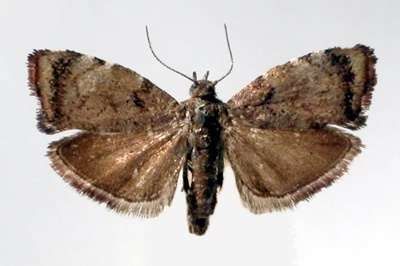Pests
Choreutis pariana Clerck - Apple Leaf Skeletonizer, Apple Leafroller
Systematic position.
Class Insecta, order Lepidoptera, family Choreutidae, subfamily Choreutinae, genus Choreutis.Synonyms.
Simaethis pariana L., Hemerophila pariana L.Biological group.
Polyphagous pest of rosaceous fruit trees and bushes.Morphology and biology.
Forewings dark brown-gray, with broken transverse brownish lines, and with a brown stripe at outer margin (wingspan 10-12 mm). Fringe with two small excisions at outer wing margin. Hindwings monochromatic, brown, somewhat darker in distal half. Eggs white, rounded, very small. Caterpillar yellowish-green, with shining red-brown dots bearing long setiform hairs. Head light brown. Pupa red-brown, covered with dense multilayer white cocoon. Moths and pupae winter; pupae winter in cocoons within fallen foliage, and moths winter under dead bark on trunks, in hollows, sometimes under the fallen foliage. Eggs are laid by groups, more often on the underside of leaves. One female lays 52-94 eggs on the average, maximum to 130. Caterpillars of 1st instar usually live by groups (5-6 in a group) at base of central vein under silky net, skeletonizing leaf. After molt, the caterpillars move one by one or by pairs on the upper side of leaves, again protecting themselves with a silky net, and feeding until the next molt. At the subsequent instars they change 2-3 leaves, bending their edges and pulling them together with silk threads. As a result, chambers are formed where the caterpillars eat parenchyma, remaining only veins and lower epidermis. Development of a caterpillar lasts 17-30 days depending on trophic and temperature conditions. Pupation occurs in dense albescent cocoons of usually 2-3 layers, at median and lateral veins of leaves, less often in bark crevices.Distribution.
The species inhabits the Western Europe (except for the north of Scandinavia), Northern Africa, Asia Minor, Iran, Mongolia, Japan (Hokkaido, Honshu); North America (adventive). In the former USSR, it is widespread in the European part (everywhere, except for the north), in Transcaucasia, Urals Mountains, southern and eastern Siberia, in the south of the Far East including Kuriles.Ecology.
Two generations in Lithuania and in northern Ukraine, 3 in Moldova and southern Ukraine, 4 in Georgia. Spring moths appear in April-May at daily average temperature 12-15°C, feeding on flowers. Caterpillars hatch in the middle or in the end of May until the 1st half of June. Flight of summer moths in Lithuania starts in the 1st third of July at degree day sum 220-298°. Moths of summer generations are active afternoon until sunset. Imagoes of wintering generation fly from the end of August or the beginning of September. They fly until the middle of October and then winter. Absence of snow cover in winter and plentiful precipitation in autumn promote their death. The main limiting factor for the species is increased humidity. The lower threshold is 13°C for egg development, 13.4°C for caterpillars, 12°C for male pupae, and 13°C for female pupae. Degree day sums are 53.6° for egg development, 205.6° for caterpillars, 74° for pupae, 333.5° for development of full generation.Economic significance.
The pest essentially damages leaves in young orchards of rosaceous pome cultures, especially apple trees and pears, in middle belt of the USSR from Lithuania, Moldova, and Ukraine to Cis-Baikalia, and also in Transcaucasia. Caterpillars also damage mountain ash, hawthorn, sloe, sometimes meeting on birches. In Lithuania, leaves are usually damaged within the limits of 20-65%, sometimes by 90%. The second generation is more nocuous than the first. Damaged leaves are deformed, being turned-in; later they dry out, turn yellow, and fall down. The degree of damage depends on a crown layer. The top layer is preferred in nurseries. In orchards, the caterpillars concentrate mainly on young leaves of middle layer of a crown or in its lower layer. Numerous caterpillars cause significant loss of leaf assimilation surface which influences maturing of fruits and formation of fruit buds. The maximal damage rate is noted on thin-skinned varieties with high sugar content in fruits, the minimal one is observed on sour fruit varieties. The yield of apples decreases by 3-4 times at abundant damage of leaves. Control measures: Agronomical ones in orchards are inter-row soil treatment in autumn for destruction of pupae, thinning of tree crowns. Biological ones include application of microbiological preparations. Chemical ones are insecticide treatments at detection the caterpillars of each generation on leaves.Reference citations:
Danilevskii A.S. & Kuznetsov V.I. 1981. Choreutidae. In: Medvedev G.S., ed. Keys to the insects of the European part of the USSR. V. 4(2). Moscow & Leningrad: Nauka, p. 103-137 (in Russian).Gershenzon Z.S. 1974. Family Glyphipterygidae. In: Vasil.ev V.P., ed. Pests of agricultural crops and forest plantations. V.2. Arthropods. Kiev: Urozhai, p. 256-275 (in Russian).
Kuznetsov V.I. 1994. Family Choreutidae. In: Kuznetsov V.I., ed. Insects and mites . pests of agricultural plants. V. 3(1). Lepidoptera. St.Petersburg: Nauka, p. 239-243 (in Russian).
Prokof.ev M.A. 1987. Siberian orchards protection against pests. Moscow: Rossel.khozizdat, 239 p. (in Russian).
Vasil.ev V.P., Livshits I.Z. 1984. Pests of fruit crops. Moscow: Kolos, 399 p. (in Russian).
Vorzheva L.V. 1958. To biology and harming activity of some little-known Microlepidoptera . pests of fruiters in Cis-Baikalia. Entomologicheskoe obozrenie 37 (4): 820-829 (in Russian).


